 ';
include("head.php");
?>
';
include("head.php");
?>
U.S. residential broadband adoption has been remarkably rapid compared with other consumer technologies and services, although from current commentary, one might not know it. Despite the economy, the dot.com and telecom troubles, regulatory disputes, loss of competitors, and higher prices, over 10% of U.S. households subscribed to broadband at the end of 2001, up from about 5% in 2000. Although a few countries have higher penetration rates and many analysts had forecast higher penetration for the United States, actual 2001 results exceeded TFI's baseline forecast from 2000. This indicates that U.S. broadband adoption is on track with long-term forecasts and that, barring major business or regulatory mistakes, long-term optimism for broadband is justified.
In the United States, residential broadband access is offered by telephone companies via digital subscriber line (DSL) service, by cable television companies via cable modems, and by wireless carriers via terrestrial links or satellite. Currently, cable modems serve 63% of the U.S. broadband market, DSL, 36%, and wireless, about 1%. How the broadband pie will be divided is crucial to the future of these companies. However, that division will depend very much on unknowns and intangibles, so here we will stick to forecasting the size of the total pie and not who gets what. We also forecast how bandwidth requirements will increase over time. Upgrading facilities to serve evolving broadband requirements efficiently will be a key to competitiveness in the broadband age.
Exhibit 1 shows TFI's current forecast for the percentage of U.S. PC and online households. The forecast for PCs include network PCs and Internet TVs capable of supporting multimedia. The online forecast governs the potential market for broadband services. Online households currently comprise over 50% of all households and are forecast to approach 75% by 2004.
Exhibit 2 shows TFI's current base forecast for the percentage of U.S. households on broadband. This forecast predicts that, by year-end 2002, about 15% of households will have adopted broadband services, up from about 10% at the end of 2001. By 2004, we expect that the percentage will exceed 30%.
Exhibit 1
U.S. PC and Online Households-TFI 2002 Forecast

Exhibit 2
U.S. Broadband Households-TFI 2002 Base Forecast

TFI also has produced a "high" forecast that anticipates a higher rate of adoption, as shown in Exhibit 3. Under the high forecast, over 20% penetration is reached by the end of 2002 and 50% penetration is reached by 2005-three years earlier than under the base case. Different assumptions underlie the base and high forecasts, as discussed below. Either is plausible, and perhaps the most likely scenario is somewhere between the two forecasts. The light-colored line shows the average of the base and high scenarios.
Exhibit 3
U.S. Broadband Households-TFI 2002 Base and High Forecasts

TFI's 2000 forecasts are shown in Exhibit 4. Note that the actual year-end 2001 penetration was about halfway between the base and high forecast. This indicates that broadband is tracking nicely with TFI's long-term forecasts. Also shown in the exhibit is the 1997 TFI forecast, which was made before there was any significant adoption of broadband services. Although at the time this forecast was considered by many to be overly optimistic, in fact, broadband has been adopted at a much faster pace than TFI forecast five years ago.
Exhibit 4
U.S. Broadband Households-Previous Forecasts
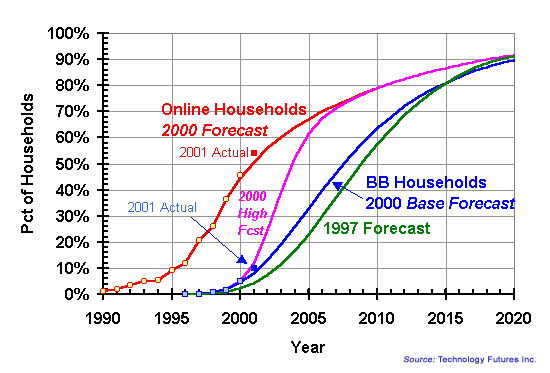
Both the base and high forecasts assume the same forecast of online households, which was shown earlier. Both first forecast the percentage of online households adopting broadband services using a substitution model fitted to the historical data. Both then multiply the result by the percentage of all households that are online to get the percentage of all households with broadband service (see Exhibit 5). They differ in that the high forecast uses the Fisher-Pry model, while the base forecast uses the Gompertz. The Gompertz model usually applies to important consumer adoptions or substitutions that require a major change in behavior or expense, for example, the adoption of PCs or online services. The Fisher-Pry model usually applies to business substitutions and adoptions, or to consumer substitutions that do not require major behavior changes or expense such as online users upgrading their modems. The rapid growth seen to date in broadband services is consistent with either model. The question is which will apply in the future, since there are aspects of both models in the current situation.
Exhibit 5
U.S. Adoption of Broadband Access-
Percent of Online Households
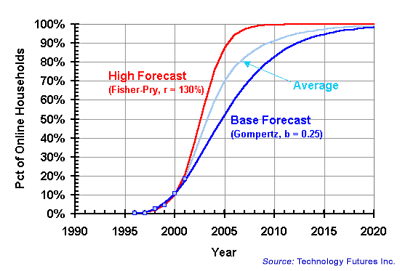
Exhibit 6 shows selected consumer adoptions fitted to the Gompertz model. Note that the shapes are similar, but the rates of adoption vary considerably.
Exhibit 6
Examples of Consumer Adoptions (Gompertz Model)
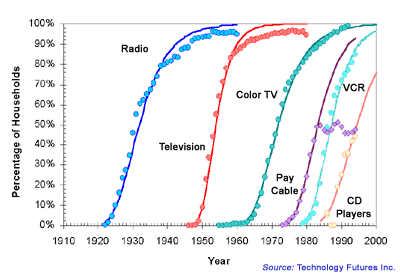
As noted, major consumer adoptions usually follow the Gompertz model, although the speed of adoption varies, reflected by the "b" value in the Gompertz. Exhibit 7 shows the "b" value for 10 well-known adoptions. It ranges from 0.10 for PCs to 0.32 for television, with an average of 0.20.
Both the high and base broadband forecasts approximate the Gompertz model when measured as a percentage of all households, i.e., after the forecast of broadband households is multiplied by the forecast for online households. From the forecast, we can "fit" the Gompertz model to calculate a "b" value for comparison purposes. The high forecast results in a "b" value of 0.32, the same as television. The base forecast results in a "b" value of 0.22, about the same as the average of 0.20. Thus, the high forecast assumes that broadband access is among the fastest adoptions, while the base forecast assumes it is typical. (Fitting the Gompertz model as a percentage of all households directly to the historical data yields a "b" value of 0.25.)
Incidentally, we used the 0.20 value in TFI's 1997 forecast (there was only a single forecast) based on analogies, since at that time there was no historical data to which to fit the models. In the 2000 forecast, we used the same method as described here: the b values for the 2000 forecasts were 0.21 and 0.32 for the base and high forecasts, respectively.
Exhibit 7
Historical Comparisons for Residential Broadband Adoption
| Analogy | Range | b |
| Radio | 1922-1940 | .18 |
| Color TV | 1955-1992 | .18 |
| Television | 1946-1960 | .32 |
| CD Player | 1986-1994 | .17 |
| VCR | 1979-1994 | .23 |
| Pay Cable | 1973-1981* | .21 |
| Personal Computers | 1980-1998 | .10 |
| Cellular | 1984-1999 | .17 |
| Online/Internet | 1992-1998 | .20 |
| Average | .20 | |
| Broadband Access | ||
| Historical Data | 1996-2001 | .25 |
| 1997 TFI Forecast | .20 | |
| 2002 Base TFI Forecast | 1996-2008 | .21 |
| 2002 TFI High Forecast | 1996-2008 | .32 |
Source: Technology Futures Inc.
* Truncated by VCR adoption.
Potential subscribers depend on telephone, cable, wireless, or other companies to install the required infrastructure and make broadband available. This means that the forecast of broadband adoption must be consistent with the likely availability of such services. Based on typical relationships between availability and adoption, we can compute the minimum availability pattern that would be consistent with our forecasts for adoption. This is shown for the base forecast by the left line in Exhibit 8, indicating that 80% of households need to have broadband service available by year-end 2005. Since this level of availability is already being approached in the United States, lack of availability is not likely to impact the base forecast, as irritating as it may be for the 20% who cannot obtain broadband.
Exhibit 8
Minimum Broadband Availability and
Adoption
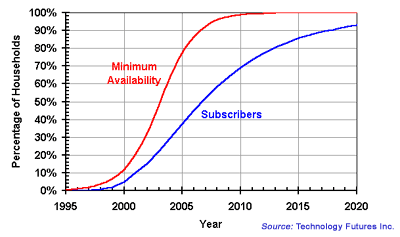
So far, we have referred generically to broadband without differentiating among data rates. We expect that the minimum competitive rate will increase over time from today's Mb/s or so. As with computer memory and processing speeds, the appetite of computer applications for bandwidth tends to push the limits of the available bandwidth. For example, commercial websites incorporate more complex images and audio and video clips, including, in some instances, real time interactivity with humans. Downloads of software upgrades, virus updates, and other files will require more bandwidth than ever. Streaming video and audio applications, including interactive distance learning and interactive games, will challenge current speed limits.
The Computer Systems Policy Project (CSPP), whose members include the top leadership of Dell, Compaq, Hewlett-Packard, Motorola, IBM, Intel, NCR, EMC, and Unisys, recently addressed the issue of higher data broadband data rates:
Regardless of the current definitions of broadband, the data transmission methods currently considered broadband will be inadequate to satisfy consumer and business demand for next-generation, valued applications. Speed is critical. Video on demand provides a useful example.... To provide streaming video using DVD-quality video, a provider would need to achieve transmission rates of almost 4 Mb/s, and high-definition video requires 19.8 Mb/s. Some experts set the frontier for high-speed access to high-quality, digital, skip-free audio and video as high as 100 Mb/s.
Another high-tech policy group, TechNet, whose members include top executives from Cisco, 3Com and Palm, Genuity, Intel, and Microsoft, has made similar comments:
Applications that will likely revolutionize how consumers use the Internet and spur consumer demand will require speeds of at least 6 Mb/s. For example, high-definition video requires 19.8 Mb/s; DVD-quality video requires 4 Mb/s to 6 Mb/s.... Providing homes with data speeds comparable to those available in offices in order to facilitate telecommuting will require speeds of 10 Mb/s... Many experts have defined 100 Mb/s as the speed at which the web's true potential can be achieved, by enabling faster surfing to streaming of high-quality digital audio and video, as well as faster upload of graphic images and large files.
For the TFI forecasts, we assume that the available data rate (and the average peak hour traffic) doubles every two years, or quadruples every four years. This, not incidentally, was the average rate of improvement in PC modem speeds from 1980 through the mid-1990s (see Exhibit 9). This 41% annual improvement rate requires that PCs, servers, and the Internet backbone continue to be improved at equal or better rates as illustrated in Exhibit 10.
We implement the projected data rate improvement in the TFI forecasts by assuming that the industry progresses through several generations of data rates similar to what we have seen for modems, with a new generation introduced every four years. We have used the nominal rates of 1.5 Mb/s, 6 Mb/s, 24 Mb/s, and 100 Mb/s in our forecasts. The 100 Mb/s category is representative of a group of rates, including the top planned VDSL rate of 52 Mb/s, 100 Mb/s Ethernet, 50 Mb/s SONET OC1, and 150 Mb/s SONET OC3.
Exhibit 9
Analog Modem and Broadband Data Rates
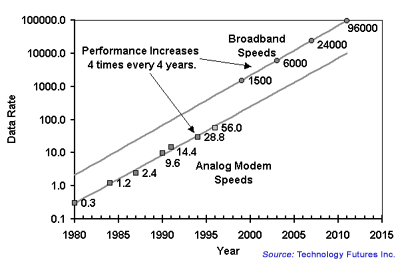
Exhibit 10
Performance Improvement Rates
| Technology | Annual Rate | Doubling Time |
| Fiber Optics (Past) | 28% | 3 years |
| Analog Modems | 41% | 2 years |
| Computers | 59% | 1.5 years |
| Internet Backbone | 100%+ | <1 year |
| Fiber Optics (DWDM) | 59%+ | <1.5 years |
Source: Technology Futures Inc.
Exhibit 11 shows our forecast of the percentage of households requiring each of these rates, assuming our base forecast of broadband households. The forecasts assume that, in any given year, different customers demand different minimum rates, because they are different in their applications, perceptions, and willingness to pay. However, as with computers, the expectations of all users increase as the technology improves. The forecasts indicate that 1.5 Mb/s will meet the typical user's expectations until about 2005, that 6 Mb/s will do so until about 2010, then 24 Mb/s until 2015, and finally 100 Mb/s thereafter. The forecasts measure the bandwidth needs of subscribers and serve as targets for service providers in terms of the number of customers served at each rate. As noted above, availability must precede and exceed demand for these forecasts to come true.
Forecasting identifiable generations of data rates in what is essentially a continuous process may seem strange. The reason we do this is to tie the demands of consumers to specific infrastructure requirements, especially as they relate to local exchange carriers (LECs) deploying DSL technology. DSL technology is available at specific data rates with specific network requirements at each rate. The most important of these is the maximum length of the segment of copper cable to the user's home, which is shown in the exhibit for each rate.
Exhibit 11
U.S. Broadband Households by Data Rate
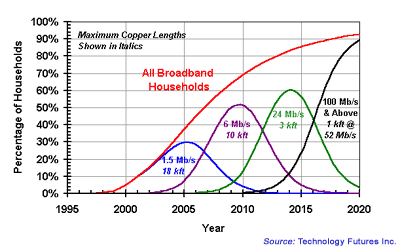
Exhibit 12 shows how the bell-shaped curves in the previous exhibit were derived. The forecasts assume that 1% of households are served at 6 Mb/s by 2003, four years after the same milestone for 1.5 Mb/s. The same milestone is assumed to be achieved for 24 Mb/s and 45 Mb/s and above in 2007 and 2011, respectively. Three Fisher-Pry substitutions are applied to the population of broadband users each with an r value of 130% (or b = 0.833). The three substitutions are 6 Mb/s and above versus below 6 Mb/s, 24 Mb/s and above versus below 24 Mb/s, and 100 Mb/s and above versus below 100 Mb/s. The bell-shaped curves are calculated by subtracting successive generations, specifically:
Exhibit 12
Nominal Data Rates as a Percentage of Broadband Households
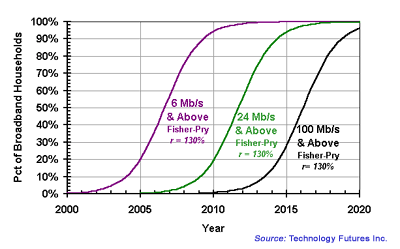
Telephone and cable companies are still making large investments to make basic DSL and cable service available. Thus, readers from these industries may find these forecasts for even higher speeds in the future daunting, and wonder where the money will come from for such an aggressive schedule. Readers from other industries may wonder the opposite: Why should it take so long? For example, the above-mentioned CSPP group declares that 50% of U.S. homes should be able to get up to 100 Mb/s affordable broadband capacity by year-end 2003. The TechNet group calls for (1) the availability of speeds of at least 6 Mb/s from two or more providers to at least 50% of U.S. households and small businesses by 2004 and (2) affordable 100 Mb/s broadband connection available to 100 million American homes and small businesses by 2010. Although it is highly unlikely that these goals will be met, they nevertheless reflect the interests of important segments of the U.S. economy.
The TFI forecasts will almost certainly be wrong in one direction or the other; however, they present a reasonable base case assuming:
If you believe that TFI could be of assistance to your organization in identifying and evaluating new product opportunities and in developing strategies for bringing these products to the marketplace, please contact John Vanston, Larry Vanston, David Smith, or any other member of the TFI consulting staff. (800) 835-3887
Copyright © 2002, Technology Futures, Inc.
All rights reserved. No part of this white paper may be reproduced in any form or by any means, other than short quotes to be used in reviews, without express permission from the publisher.
Printed in the United States of America.
Published by Technology Futures, Inc.
13740 Research Boulevard, Building C
Austin, Texas 78750-1859
(800) 835-3887
(512) 258 8898
Fax: (512) 2580087
www.tfi.com